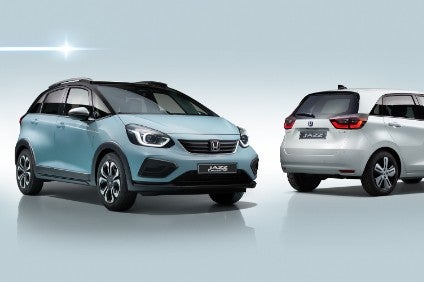
Honda has unveiled the redesigned, fourth generation Jazz [aka Fit], featuring advanced two-motor hybrid powertrain technology as standard for the first time.
The new Jazz will introduce the efficiency benefits and performance of hybrid power to the mass market and accelerate Honda towards achieving its ambition of all its European mainstream models to feature electrified powertrains by 2022.

Discover B2B Marketing That Performs
Combine business intelligence and editorial excellence to reach engaged professionals across 36 leading media platforms.
The next-generation Jazz will be the first model in Honda's European line-up to wear the new e:HEV powertrain badging. This is the first example of Honda e:Technology branding that will feature across all future electrified products.
Another addition to the Jazz range is the new Crosstar variant, designed to appeal to those seeking a more crossover style design, similar to Ford's Active series. Available with the same hybrid powertrain and interior features as the standard model, the new Crosstar features increased ride height, a unique front grille design, water-resistant upholstery and integrated roof rails.
Thanks to new structural technologies, the A-pillar is half the width of that on the previous model, improving forward horizontal visibility. The sleek A-pillar design is enabled by greatly improved torsional rigidity and new structural technologies that move impact stress towards the front quarter light pillars.
For the first time ever in Europe, Jazz will only be available with an advanced two-motor hybrid powertrain which, Honda said, provides an exceptional blend of strong and effortless driving performance and impressive fuel economy. The system is newly developed for the Jazz and provides a smooth, responsive and direct driving feel.
Intuitive infotainment technology with seamless in-car connectivity and a WiFi hotspot are available. The new LCD touchscreen interface features familiar smartphone-style usability, with swipe controls to browse recently used applications and media lists. The comprehensive suite of in-built apps can be supplemented by seamless smartphone mirroring, via built-in Android Auto and Apple CarPlay which is available via a wireless connection for the first time.
New wider, body-stabilizing front seats feature mat-structure support, replacing the previous spring set-up, to help prevent fatigue on long journeys. Improved rear-seat design and a thicker rear seat pad provides greater comfort for passengers too.
The new Jazz retains class-leading levels of interior space that was the hallmark of previous generations through the clever packaging of hybrid drivetrain components into the chassis and within the engine bay. Key to maximising cabin room is the positioning of the fuel tank in the centre of the chassis beneath the front seats, which is unique in this class. This enables the Jazz to retain the exceptionally versatile rear Magic Seats that offer both fold flat or flip up seat flexibility, depending on cargo space required.
Honda claims it will provide the most comprehensive suite of advanced safety features and driver aids in the Jazz class.
The scope of the brand's Honda Sensing technology has been enhanced with the application of a new wider, higher-definition camera, replacing the previous camera and radar set-up. This enables improved awareness of vehicle surroundings, including recognition of verges without kerbs or roadside markings.
The Collision Mitigation Brake System (CMBS) is improved with night time operation to detect pedestrians and cyclists when there is no street lighting, and now applies the brakes when oncoming vehicles cut across or turn into the path of the car. The new camera system also enables Adaptive Cruise Control (ACC) to follow traffic at low speeds in congestion and applies Lane Keep Assist on urban and rural roads – as well as multi-lane highways – for increased safety in more situations.
Sales in Europe start in mid-2020.






